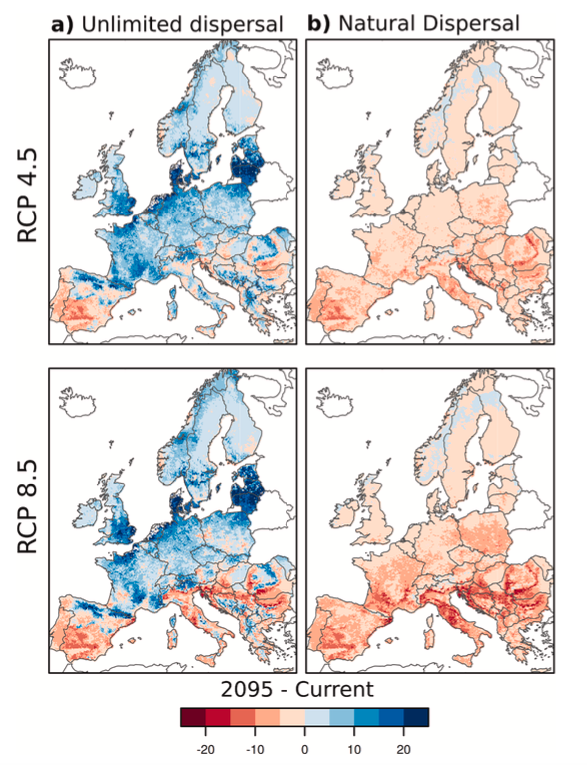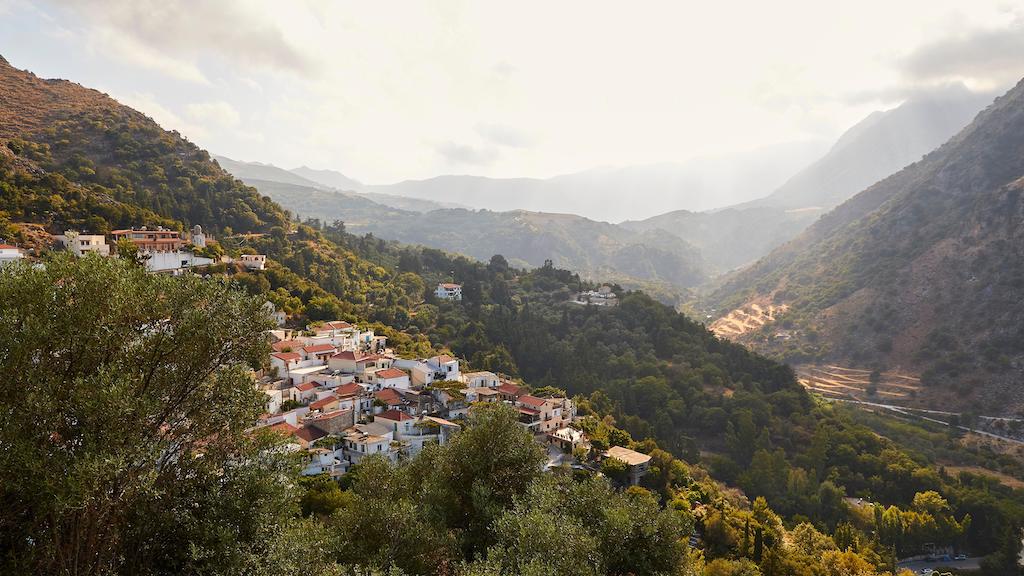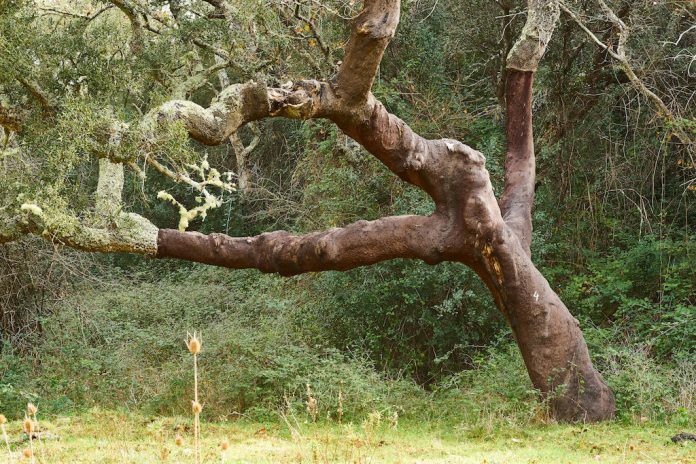The benefits that Europe’s forests offer to people and nature will decline significantly this century, new research concludes.
However, it also notes that more strategic tree planting can reduce, but not entirely stop, these losses.
The study states that the “ecosystem services” provided by forests, such as protecting soil or providing food, will decrease by an average of 15% by the end of this century in a moderate emissions scenario.
Those losses can be partially mitigated if more attention is paid to the types of trees planted across the continent, the study says.
However, the study, published in Global Environmental Change, says that despite the new strategies evaluated in the study, the Mediterranean will still see high losses of key benefits as conditions become drier this century.
A researcher not involved in the study told Carbon Brief that the findings are consistent with other research showing that “forests, particularly in the Mediterranean region, are quite severely affected by changes in weather patterns.”
“Decline in Forest Production”
Forests offer many benefits to people and the environment. Some of these are direct, such as wood for fuel and construction. Others are indirect, such as protecting soil from erosion.
A 2020 report by the EU’s Joint Research Center says forests are the bloc’s largest terrestrial ecosystem. They are home to biodiversity and contribute “significantly” to climate protection, the report adds.
According to the European Environment Agency, around 10% of the EU’s annual greenhouse gas emissions are absorbed and stored in forest soil and trees.
However, climate change has already made forests in Europe more vulnerable, according to a 2021 study by Nature Communications. It noted that carbon sequestration, biodiversity conservation and other essential services could be “seriously impacted” in the future due to the effects of climate change.
And extreme heat and flooding will become more frequent in Europe in the coming decades, with a range of impacts on forest services, according to the Intergovernmental Panel on Climate Change (IPCC).
The new study examines three forest management strategies aimed at reducing or reversing the loss of benefits that forests provide.
The first strategy selects random species to replace the lost ones. The second chooses substitutes that maximize a particular ecosystem service, such as soil conservation. The third strategy identifies the types that offer the best overall result for all services.
The researchers used species distribution maps from a dataset they previously developed called EU-Trees4F. This includes current and future potential distributions of 66 tree species in Europe under different emission pathways and species distribution possibilities. These species range from horse chestnut and ash to pine and sycamore.
The future prospects assess the dispersal of species under one scenario in which the trees will spread naturally and in another in which they will spread with human help to more areas where they are climate-suited.
Each strategy is evaluated under two future emissions trajectories: a moderate emissions scenario (RCP4.5) and a very high emissions scenario (RCP8.5).
Cork oak in Alentejo, Portugal. Credit: David Robertson / Alamy Stock Photo.
Researchers modeled various ‘optimal’ combinations of tree species in a forest to maximize the benefits they can provide.
In each scenario, the researchers find that replacing locally lost tree species with ones better suited to future climate conditions can reduce the decline in ecosystem services compared to scenarios without such “assisted migration”.
benefits for humans
The researchers look at seven performances for each tree species: construction; cultural (e.g. species in areas used for recreational or spiritual purposes); Eat; Firewood; medicine, pulp paper; and soil protection.
Other benefits, such as carbon sequestration, were not examined because consistent data was not available for all tree species in the study, the researchers said.
They note that there are “inevitable trade-offs” when trying to optimize all of the different benefits.
dr Achille Mauri, the study’s lead author and post-doctoral researcher at the University of Helsinki, notes that selecting species that mainly serve a single service, such as timber production, poses a risk and may be ‘neglected'[ing] other ecosystem services, such as biodiversity”.
The study estimates that in a moderate emissions scenario, the services provided by forests will decline by an average of 15% by the end of this century without human intervention in Europe. This drop could reach up to 52% in the Mediterranean on the same future path.
With the help of tree migration strategies – moving tree species to an area where they may not previously have been grown – these losses could be reduced to an average of 10%, the study says.
However, it notes that even with human intervention, ecosystem services in the Mediterranean will continue to decline by about a third by the end of this century.
The map below shows the changes in tree species abundances by the end of this century compared to their current levels. Results are shown for both emission pathways RCP4.5 (top) and RCP8.5 (bottom).
 Percentage changes in tree species richness by the end of the 21st century compared to today under a moderate emissions scenario (top) and a very high emissions scenario (bottom). Two dispersal scenarios are examined: an unbounded species dispersal, where all possible areas contain suitable tree species and the range increases, shown in blue areas (a), and a natural dispersal scenario, where many tree species decrease their range, shown in red is B). Source: Mauri et al. (2023).
Percentage changes in tree species richness by the end of the 21st century compared to today under a moderate emissions scenario (top) and a very high emissions scenario (bottom). Two dispersal scenarios are examined: an unbounded species dispersal, where all possible areas contain suitable tree species and the range increases, shown in blue areas (a), and a natural dispersal scenario, where many tree species decrease their range, shown in red is B). Source: Mauri et al. (2023).
Mediterranean impact
According to the IPCC, higher temperatures and lower precipitation will make the Mediterranean Sea drier in the future. Warming of 2°C or more will also lead to an increase in droughts and fires across the region, which spans all of Greece, Malta and Cyprus and parts of France, Portugal, Italy and Spain.
The study finds that this region will reap fewer benefits from assisted tree migration in the coming years compared to other parts of Europe.
According to Mauri, these “worrying” results could be overly pessimistic because the study only includes European tree species. Bringing tree species from North Africa, which has a similar climate, to the Mediterranean region could be a solution. However, he notes that introducing new species can have “important consequences” and create potential problems.
Some species already grow in parts of the Mediterranean and North Africa, such as cork oak and Juniperus thurifera.
Prof John Mackay, a forest geneticist at Oxford University, tells Carbon Brief that bringing in tree species from other areas is “a sensible solution” in certain circumstances. He adds:
“There are reservations about introducing exotics as they are generally expected to be less well adapted to other organisms found in the ecosystem.
“The truth is that Europe is already full of exotics. It’s nothing new… It needs to be done carefully, but I think it can help. The loss of ecosystem services can be very drastic. For example, a lot of soil erosion can end up happening, and that has knock-on effects.
“Something like this could become necessary in the future. There is always a compromise. But if you can preserve the forest, I think some compromises are acceptable.”
Future “extreme” conditions
According to Mauri, a reduction in ecosystem services in forests causes “fundamental problems”. He tells Carbon Brief:
“Forest production and forest ecosystems, such as the wood used as building material, will decline significantly.”
In addition to “falling forest productivity in the future,” it will have other impacts on species, wildlife and biodiversity, he adds.
According to Mackay, this study is consistent with other research that has found “that forests, particularly in the Mediterranean region, are quite severely affected by changes in weather patterns, including severe weather events.” He adds:
“Typically, tree species adapt to the climate and general conditions in which they grow. It is a slow evolutionary process that may involve some natural migration. But trees are among the species that migrate the slowest. They obviously cannot move like animals would. Their seeds and pollen can be dispersed, but it remains a slow process. So, with assisted migration, we can accelerate that.”
 Aerial view of a village surrounded by forest in Crete, Greece. Credit: imageBROKER / Alamy Stock Photo.
Aerial view of a village surrounded by forest in Crete, Greece. Credit: imageBROKER / Alamy Stock Photo.
The authors write that assisted tree migration may play a “critical role” in maintaining forest ecosystem services in the future.
The study concludes that its framework “can serve as a science-based basis for decision-making” and can help inform EU environmental and biodiversity plans, such as the EU’s pledge to plant 3 billion trees on the continent by 2030 to plant.
A key implication of the findings, according to the study, is that the strategies reduce ecosystem service losses under both moderate and high-emission future pathways. This means the solutions are effective no matter how much emissions rise, it adds.
According to Mauri, the results can help forest managers “decide which tree species to plant in the future.”
Although introducing a specific tree species that is better adapted to warmer conditions can increase their resilience, Mackay warns there is a limit. He tells Carbon Brief:
“When conditions get extreme, this evolutionary change just isn’t enough to compensate.
“That’s really important because unfortunately there’s this idea that ‘oh, trees are only going to save us from climate change, we just have to plant more trees to absorb more carbon.’ This is where it runs into problems. The trees themselves are affected by the changes, so they will not be able to make massive changes in the future.”
Maurie et al. (2023), Assisted tree migration may reduce but not prevent decline in forest ecosystem services in Europe, Global Environmental Change, doi:10.1016/j.gloenvcha.2023.102676
Sharelines from this story
www.carbonbrief.org
https://www.carbonbrief.org/helping-climate-compatible-trees-spread-their-seeds-may-benefit-europes-forests/













